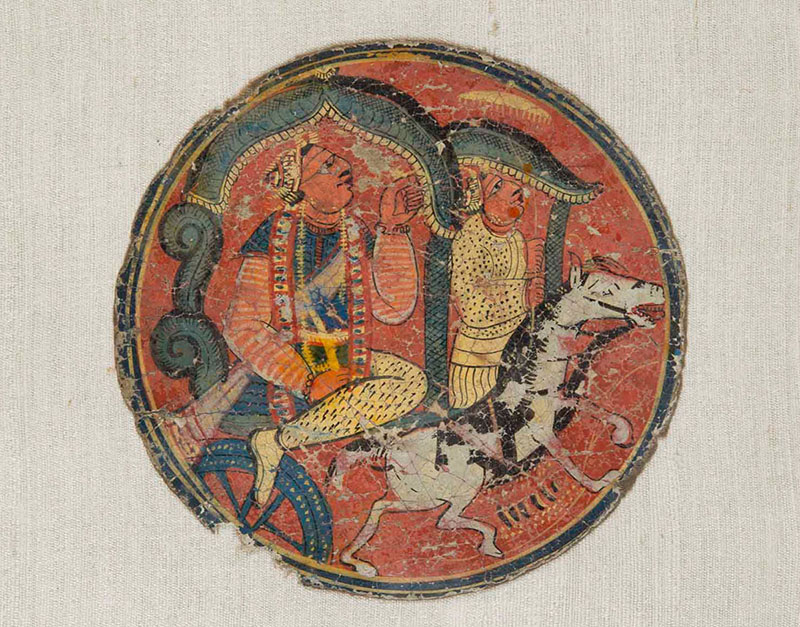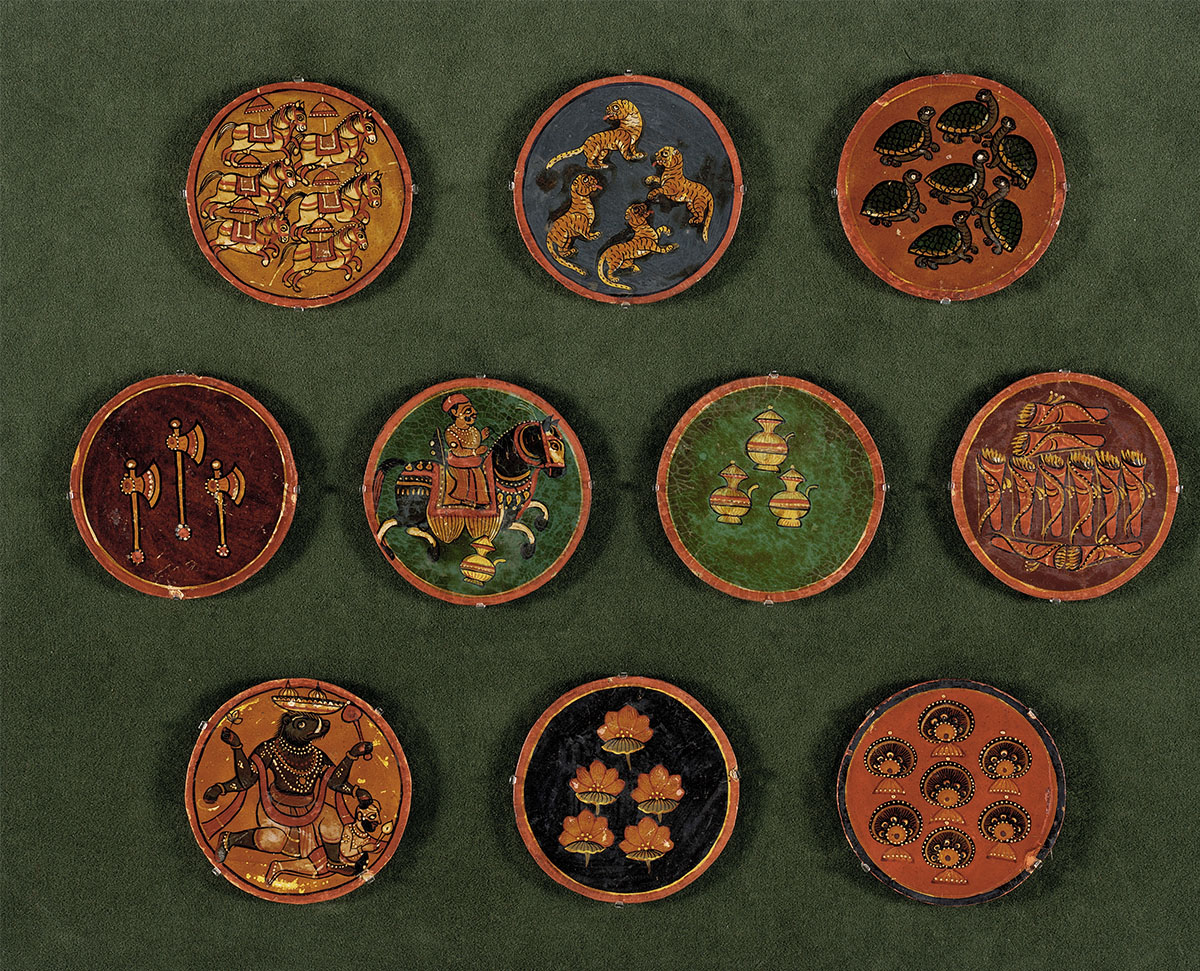Encyclopedia of Art > Articles
Ganjifa

A Persian card game that has been popular in the Indian subcontinent since the sixteenth century, Ganjifa is notable for its hand-painted playing cards. The name Ganjifa likely derives from the Persian word ganj, meaning treasure or money. The game has several variations across West, Central and South Asia.
The oldest surviving reference to Ganjifa in India was made in the early fifteenth century by the historian Ibn Taghribirdi, who wrote that a Mamluk sultan gambled with kanjifa (a medieval Arabic name for Ganjifa) as a young man. The game likely made its way to India through the Mughals and is referenced in a journal entry by Babur dating back to 1527 CE. A description of the gameplay of this early version of Ganjifa can be found in the Humayun-nama, a sixteenth century text by Gulbadan Begum. There have been several variations of Ganjifa since the game was first introduced, each with a distinct iconography, deck and cultural context. In the case of Ganjifa decks made with Hindu imagery, there is also considerable influence from Kreeda Patra, an older card game from India.
Like games such as chess, the cards of Mughal Ganjifa (also known as Safvid Ganjifa) depict figures and objects closely associated with imperial courts of the time. There are ninety-six cards in a pack, divided into eight suits of twelve cards each. The pack is divided into two parts or bhedas containing four suits each, with every suit containing two court cards called shah (king) and wazir (minister) as well as numerical cards from one to ten. The court cards of a suit are its strongest. The bishbar bheda has ten as its strongest number card and one as its weakest. The kambar bheda is reversed, with one being the strongest. The names of the suits – according to the set described by poet Ahli Shirazi in the early sixteenth century – are gulam (servant), taj (crown), shamsher (sabre, or curved sword) and tanka (silver coin) in the bishbar bheda, and barat (cheque or draft), qimash (material wealth, usually in the form of textiles), ashrafi (red or gold coin) and chang (a small harp) in the kambar bheda.
While packs used by the Mughal court were made with precious materials such as ivory and tortoiseshell, the cards used by the general public were made with starched cloth, papier mache or palm leaf, and sometimes with a lacquered face. Ganjifa cards were historically elaborately painted, although factors such as demand, prevailing tastes and scale of production did impact the quality of card design at different points in time. Unlike the rectangular West Asian cards, Indian Ganjifa cards are typically circular in shape. The court cards are usually the most meticulously designed, reflecting their typically high status in the gameplay. These cards, especially those from packs used by royalty and nobility, were often treated as miniature paintings in their own right, with a king or minister painted atop a horse against a background of hills or forest, and the symbol of the suit deftly worked into the composition.
As with Western playing cards, the numerical Ganjifa cards depict their suit in the relevant number: a ten of taj will feature ten crowns, a six of ashrafi will show six gold coins, and so forth. Visually, these may be arranged loosely on the card’s face following no particular order, or by dividing the circular card into triangular segments, akin to a pie chart, or in some cases as individual flowerheads on a tree-like form. Despite the word gulam meaning slave or servant, cards of this suit often feature comical characters or stereotypes from local stories, or even full scenes of human figures, with the number of individuals reflecting the value of the card. In such cases, the shah and wazir are given an entourage in their respective cards.
The jewelled crown of the taj suit is likely modelled after the Sassanian-style crown used in Persia, or the Timurid headdress from Central Asia, which is in turn a more elaborate version of the Mongolian hat. The shamsher suit is relatively uniform, usually showing a similar curved sword in every pack, with the grip sometimes being covered by a knuckle-guard. The figures of the shamsher court cards are often shown in battle armour, perhaps to compliment the weapon. The motif on cards in the chang suit is a small harp of Persian or Chinese origin. The court cards for the chang suit show only women playing the harp. In the case of the shah card, the woman sits on a throne among companions, and in the wazir card she rides a camel. The instrument itself never gained popularity in India and has historically caused the most confusion among Ganjifa artists, leading to this suit being drawn in a variety of imaginative ways. The two money suits, tanka and ashrafi, are represented by silver and gold coins respectively. Additionally, the ashrafi suit’s court cards are shown as lions, tigers or the sun, possibly due to the association of these symbols with the imperial courts of West and Central Asia at the time. The qimash suit, intended to represent comfort, depicts stylised bolsters commonly used in North India. The barat suit has the simplest motif, usually a rectangle, or occasionally a circle, with a green outline.
The rules of Ganjifa are largely consistent across its various versions. A game typically has three players and lasts three rounds, although this can be adjusted if required. The objective of each round is to make hands or tricks. When the round concludes, the player with the lowest score is obliged to exchange their high cards for the others’ low cards in the next round. The number of cards exchanged depends on the number of tricks lost.
Several variations on the Mughal game have been designed over time, some of which include: a twelve-suited version invented by Akbar; Ganjapa, which is played in Odisha today and closely follows Mughal Ganjifa; the ten-suited Dashavatara Ganjifa, made according to the ten incarnations of Vishnu; Mysore Chad Ganjifa; Naqsh Ganjifa; Sawantwadi Ganjifa from Maharashtra; and Ramayana Ganjapa, also from Odisha. The game is rarely played today, with painters (or chitrakars) in Odisha, Maharashtra and Mysore occasionally producing novelty packs intended as display pieces.
From the early twentieth-century onwards, Western playing cards became more popular in India than Ganjifa, due to their simpler four-suit system, easily mass produced cards, and the wide variety of games that could be played. In recent years, artists and institutions have taken some steps to revive Ganjifa, a notable example of which is Splendours of Ganjifa Art, a book on the game’s history released by the Chitrakala Parishath, Bengaluru in 2019.
First Published: April 21, 2022
Last Updated: July 26, 2023



